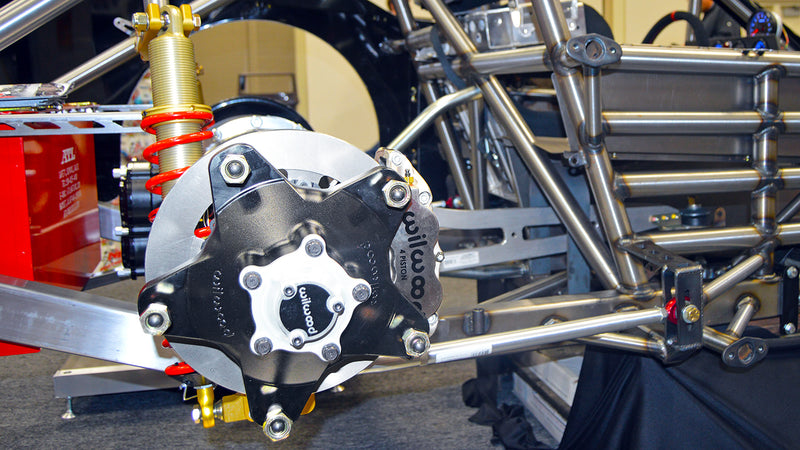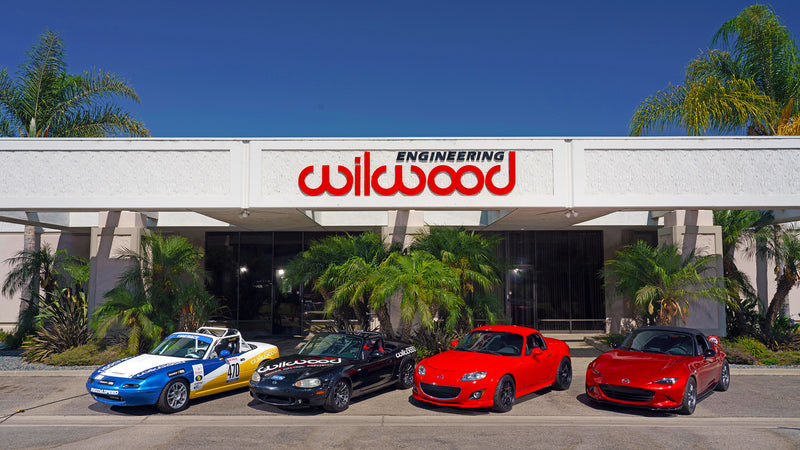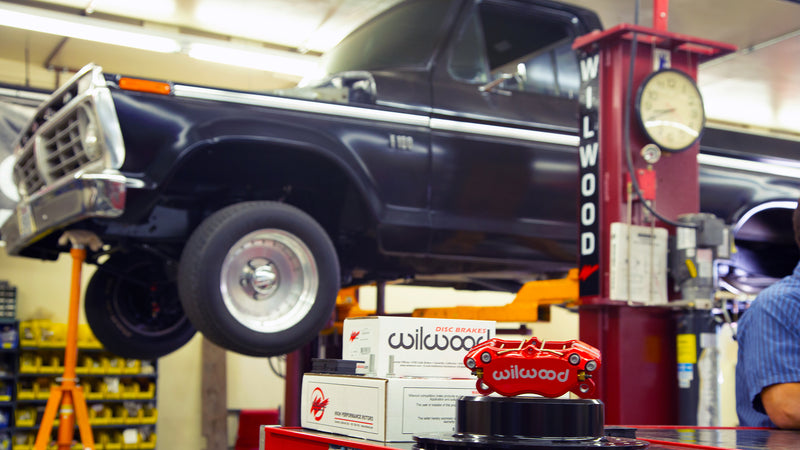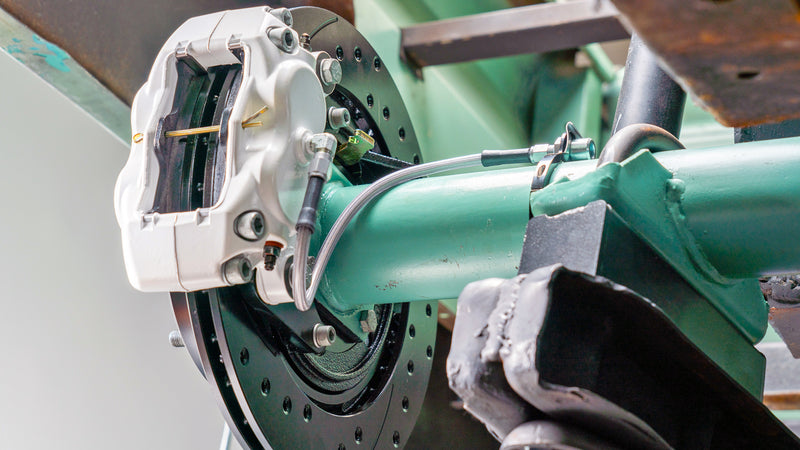
The Innovative "Bubble" Wide Five Racing Hub
The "Wide 5" hub is now common in many racing classes, mostly on oval short track, for its ability to handle abuse and massive lateral force. For those unfamiliar with the concept, the wide 5 system uses a large aluminum hub with the wheel mounting studs way out by the wheel's rim. Officially, the bolt circle is 5 x 10.25", but (except for early VW and Porsche models, which have a smaller wide 5) all wide 5 wheels and hubs have the same bolt pattern.
Where Did Wide 5 Come From?
The history of the wide 5 style wheel starts way back in the early days of mass-produced automobiles. Many cars initially used wire-spoked wheels like a bicycle or wooden spoked wheels with a metal hub like a horse cart. In 1936 Ford changed their passenger cars to a steel wheel that was mostly empty space, with a hub/brake drum that had 5 wheel studs way out on the edges. They used this design on their cars until 1939. There is speculation that Henry Ford used these because they were much cheaper, but there is no question they were lighter and stronger than what they replaced.

Ford's commercial trucks adopted the wide 5 hubs shortly afterward and brought another staple of racing - the bolt together "3/4-ton" differential. With these units, typically from Spicer/Dana, racers would take two left sides and bolt them to an aftermarket "Quick Change" center section. Quick change rears were more robust than most passenger car differentials, readily available, and allowed fine-tuning the gear ratio for different tracks.
The truck-based set up had other advantages, like larger, heavy-duty wheel bearings, stronger brakes, and floating axles. The differential designed for trucks mounted the hub to a snout with a 2-inch diameter, and a pair of bearings spaced several inches apart. The axle only drives the wheel; it doesn't have to hold the hub in place or support it. The axle "floats", held to the hub by a bolt-on cap with internal splines. This is much stronger than the wheel bolting to the axle and supported only by one bearing in the axle housing, several inches away.
As speeds increased, racers found the wide 5 to be superior to modern wheel hubs' center bolt style. When sliding around a corner at 100 mph, it was not uncommon for the center of a 5 x 5" bolt pattern wheel to rip out. With the rim practically bolted right to the hub on a wide 5, this didn't happen.
The basics of modern short track racing were all there in their simplest forms just after WWII, but they were crude, and they were mostly heavy cast iron. Still, some racers continued with the iron hubs into the 1970s.
The Wilwood Wide 5 “Bubble” Hub
As time went by, various companies offered aftermarket versions of the Ford hubs, cast in aluminum to be lighter, or modified to use big Buick 12" drum brakes. Some companies even went as far as to cast magnesium or aluminum hub/brake combos, with iron linings for the brake drum. As disc brakes became widely available, wide 5 hubs with mounting tabs on the back for brake rotors were designed and made by companies like Safety Racing, Winters, and others, including Wilwood. These hubs were still similar to the old Ford unit, just cast in a lighter material.
That changed in the 1970s, though, as Wilwood put some serious engineering effort behind new hub designs. The original Starlite hub (no longer available) was the result, named after its 5-point star shape and lighter weight. By concentrating metal in the center to connect the drive axle and brake disc, with wheel bolts in the points of the star, the whole unit could be lighter. Another benefit was more air flowing around the rotor and caliper to cool it.
These hubs were made in aluminum and magnesium and appear in some of the earliest Wilwood catalogs. They were well-engineered but not that different from other hubs on the market.
This was just the beginning, though, as the revolutionary Starlite II "bubble" hub would change everything in 1981.
The "bubble" hub literally turned things inside out. Instead of a central column of metal with five arms growing out of it, the middle of the Starlite II was full of air. A cast shell of aluminum transferred force from the central drive flange to the outer wheel bolts, and on the back, an eight bolt rotor mount held the brakes. This design made the "bubble" hub 3 to 6 pounds lighter than other, solid hubs, even the magnesium ones!
Racers were suspicious of this innovative hub at first - how could it still be strong enough if it was mostly hollow? New York Modified champion Richie Evans wasn't worried about them failing, though. He quickly integrated the hubs into his #61 Pinto for the 1981 season. At the Dogwood Classic at Martinsville Speedway, VA Evans battled Geoff Bodine for 250 laps, resulting in a spectacular last-lap crash. Richie Evans crossed the finish line in the lead, with two wheels up on the wall and one wheel wholly torn from the car.
But the new lightweight Wilwood Starlite II "bubble" hubs were undamaged. Even the missing wheel, once recovered, was found still bolted to the hub, and the hub was still attached to the spindle securely.
The Wilwood Starlite 55 and 55XD
Forty years later, the revolutionary bubble style Starlite is now the standard that others try to emulate. Currently, the Wilwood catalog has two versions, the Starlite 55 and the Starlite 55XD. Both are evolutionary improvements on the Starlite II to make a more substantial, lightweight hub.The Starlite 55 follows the new industry standard by utilizing the 5-bolt drive flange instead of the original eight bolt style - the 55 model name is short for wide 5, 5 bolt drive flange. The new design was made lighter by removing those 3 steel bolts and their corresponding mounting bosses from the hub. Because the front hubs don't need any drive flange, the five mounting bosses are machined away entirely, with a snap-on plastic cap to seal the bearings. These hubs weigh less than seven pounds each with drilled wheel studs.
The latest Starlite 55XD applies similar thinking to the rotor mounting on the backside. Instead of 8 mounting bosses around the perimeter, there are 5, cast in where the hub is strongest, around the wheel bearing. With many racers running floating rotors attached to an adapter, we redesigned the hub and adapter for maximum strength without adding any weight.
Because racecars seem to get faster every year, Wilwood is constantly working to make our race parts better. To handle the extreme heat without distortion, we created the zero offset adapter 300-14294, to dynamically mount floating rotors to any wide 5 hub with a 8x 7.00" circle. The adapter that comes with the Starlite 55XD hub, part number 300-11211, allows static or dynamic mounting of any rotor with a 8 x 7.00" bolt circle.
Another advantage of the wide 5 hub and floating axle set up, is the ability to add camber to the rear wheels. Years ago, some builders would just tweak the solid differential housing to give the rear wheels negative camber for better grip and handling, but this caused more wear and tear on the bearings and axles. Now, with floating axles, a wide 5 hub, and Wilwood's 2-degree drive flange with internal ball splines, part number 270-16183, you can set up the differential with camber without adding bind or wear.
Wide 5 Hubs on Street Cars
The saying goes that once you see something 3 times, it is a trend...

In the last 10 years, more and more street driven and show cars with wide 5 hubs have been popping up. With the move toward pro-touring and autocross events for older cars, builders have been finding the cars built for 6-inch wide bias-ply tires can only take so much modern grip before the spindles or axles start to deflect. Vehicles like the Hellboy Chevy C10 truck, Scraptona Dodge Charger Daytona, and others have been seen at the SEMA show, Goodguys events, and elsewhere with wide 5 hubs and foot wide street tires on all four corners.

Wilwood does not make wide 5 hubs for street car use, but they are undoubtedly strong enough to handle the abuse if they run mile after mile on the race track. The bad news is that using them on a street car is no simple bolt-on. However, the good news is that they are so common in circle track racing that there are shops all over the country familiar with them. Unfortunately, we can't offer much help with figuring out how to run them on your car, though.

In the rear, mounting a wide 5 requires having a race-style rear end built with the correct 2" threaded flange and floating axles. If you are building a serious, dual-purpose, street/track car, or a hot rod where the differential will be more exposed, you can't beat the quick-change rear's look and function. Wide 5 flanges that weld or bolt on are available, and you can even buy bare axle housing tubes to adapt to various differentials, but the right full floating axle setup is a must.
In the front, because "Stock Cars" at one point were actually stock cars, things are more straightforward. Some racers still use a spindle that originated with 1971-76 Chevy Impalas, and you can get wide 5 adapter snouts for these Impalas. You are on your own when adapting the Impala spindle to whatever you are building, though.
Custom fabricated racecar spindles do come in various heights, pin inclinations, spindle height, steering arm dimensions, and ball joint sizes. There are even shops out there who will fabricate them to your specifications. Now you just have to make measurements and study up on chassis geometry.
Since Wilwood brakes are so prevalent in these forms of racing, you should have no problem mounting calipers to any wide 5 spindle. Most wide 5 hubs have mounting bosses on the back, allowing various Wilwood rotors with an 8 x 7.00" bolt circle to bolt to them. Rotor size is limited by wheel size, but diameters up to 13.06" are available if you can fit them.
The biggest drawback to running wide 5 hubs is the lack of wheel options in modern tire sizes. Most race classes still limit cars to 15-inch diameter wheels and tires, so those are the readily available wheels. Without resorting to custom fabrication, you can find 16-inch diameter wheels without too much trouble. But if you plan on using wide 5 hubs for their strength and not just the look, you will have to have custom wheels made in modern diameter with the 5 x 10.25" wide 5 pattern to utilize modern wide sticky tires. For reference, the Cobra at the top is using 15" wheels, the Scraptona and the C10 truck use custom fabricated wheels in 20" and 18", respectively.Similar Articles
Mazda MX-5 Miata Brake Kit Buyers Guide
When the Mazda MX-5 Miata was introduced in the early 1990s, conventional wisdom was that nobody wanted a small two-seat convertible sports car. The British sports cars that had defined... Read More
The Wilwood Shop Truck F100 - From Pack Mule to Show Horse
After Wilwood’s Workhorse Mustang was on the road, our R&D guys started itching to start a new project. A clean, rust-free, but otherwise unremarkable 1974 Ford F100 short-bed pickup truck... Read More
Wilwood Rear Flexline Kits with Clamp or Weld On Axle Mount
Cars and trucks originally built with rear drum brakes (and even some factory disc brakes) on a solid axle typically have a rubber flexline in the center of the car... Read More











0 comments